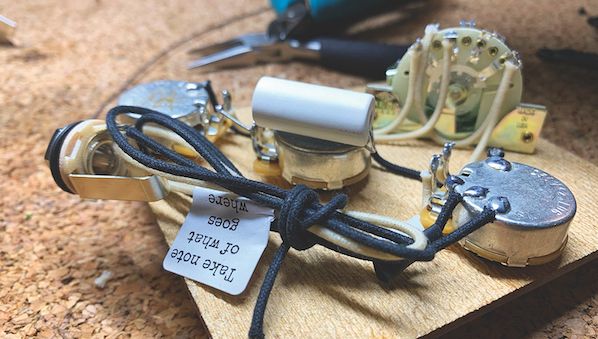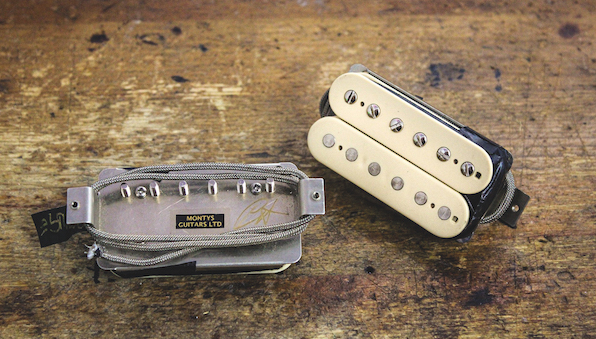Want to squeeze a little more tone from your guitar? Try new wiring
Tone expert Matt Gleeson of Monty’s Guitars explains why a new wiring loom can turn a good guitar into a great one

Most of us have swapped out pickups or pots on our guitars, but increasing numbers of guitarists are now opting to replace the whole wiring loom that came as stock on their factory-built guitars with a high-end aftermarket replacement.
The term 'wiring loom' describes the network of electronic components inside your electric guitar that connects your pickups to tone and volume controls and routes the signal out to the amp. It might sound dull, but upgrading the quality of these parts can yield significant tone benefits – and the good news is you can upgrade the whole shooting match in one go, rather than piece by piece.
Ready-made looms, also known as pre-wired assemblies, are available to fit most major models of electric guitar and are produced by a number of specialist companies, including Monty’s Guitars, which is run by Matt Gleeson. Matt joined us recently to talk about the pros and cons of fitting a new wiring loom spec’d out with vintage-correct capacitors, pots and other high-quality components.
First up, we asked him when is the right time to consider a replacement loom, not just the odd component?
“The decision-making route I take is this,” Matt says. “First, set the guitar up. Before you start spending money on upgrading your guitar I really do believe you need to make sure that it’s playing in tip-top condition. If your strings aren’t vibrating as they should do, for example, your pickups are never going to ‘see’ what they need to see to create the optimum tone. So make sure that you set it up well first. And if that doesn’t solve it then try changing pickups, then consider a replacement loom.
“Most guitars do come with fairly good looms,” Matt continues. “If you’ve got an American- or Japanese- built guitar – and particularly anything from a custom shop – the components are going to be really good to begin with. But, even if that’s the case, there are still reasons why you might want to look at a replacement loom.
“If you take modern Les Pauls for example, the way that the tone control is wired up actually knocks off a little high-end, even with it fully open so it’s not really engaging. That’s because of what’s known as parasitic capacitance – everything that you add into a signal path affects the tone in some way, puts extra resistance in the circuit, all that kind of thing,” he explains.
Get The Pick Newsletter
All the latest guitar news, interviews, lessons, reviews, deals and more, direct to your inbox!

“By contrast, the way that they did it in the 50s, instead of linking the tone control from the input on the volume control, it’s from the output. This affects the high-end less, so there’s a little bit less of that roll-off and the sweep on the tone control is actually slightly nicer, more usable,” he adds.
“The only downside to this older way of wiring up Les Pauls – if you consider it a downside – is that the controls are a bit more interactive with each other. So if you back the tone control off, the volume may change a little bit, depending on the kind of pickups that you’re using and all that kind of stuff.
“But not only can you wire up Les Pauls and Gibson-style things that way but also Telecasters – and we’ve figured out a way to do it with Strats, too, so you can have more usable sounds than would come as stock.”
Switches, capacitors and pots
As well as different tonal and interactive qualities, a high-quality replacement loom will often feature more reliable switches and terminals, Matt says.
“We use CTS pots because they’re rock-solid reliable and we get them from one supplier who makes sure the tolerance [adherence to rated specifications] is really good. I like the pots not to be too stiff and we also specify a vintage taper on our pots,” he adds, referring to the rate at which the pot rolls treble or volume off when turned.
“When it comes to switches, we use CRL parts for Strats and related guitars. They’re a little bit more money to buy but they’re rock-solid and the mechanism is spring-loaded so it lasts for longer as opposed to the other type, which have a little bearing and notches along it. Those work fine but the CRL ones work fine for longer. When it comes to Les Paul switches, it’s all Switchcraft – again, for the same reason, which is that they’re really, really reliable.”
Moving on to the subject of capacitors, which are sometimes purported to have a magical effect on improving tone, Matt says he’s moved from being a sceptic on this subject to a real believer, though with the caveat that people should expect a tangible improvement from good caps, not a miraculous one.
“All the caps we use are new old-stock Russian caps that I found when I was browsing the internet after maybe a couple of beers on a Sunday evening. I sent an email over and got this reply from some guy called Dennis who said he’d come across an old stash of all this stuff, so it wasn’t just caps it was old valves and all kinds of Russian electronics. So I took a punt and ordered a few and they were really, really good. As you rolled back the tone, there was still clarity there – and that’s what you get with old bumblebees.
“For years I thought it was all bollocks,” Matt admits. “I thought that as long as you’ve got something decent like an Orange Drop cap in there, you’re fine. But then one day a customer came in and he’d bought some old [Sprague] bumblebee capacitors and had paid a fortune for them.
“I’d already done loads of work on his Les Paul – refretted it, new pickups, new loom, all sorts – and the guitar sounded great. But then I put the bumblebees in and it was like a fine layer had been lifted off the sound, which gave us the final 0.01 per cent needed for perfection. As with all of these things, they may not make a massive difference in isolation but it’s sometimes enough to turn a great guitar into an amazing guitar.”
Jamie Dickson is Editor-in-Chief of Guitarist magazine, Britain's best-selling and longest-running monthly for guitar players. He started his career at the Daily Telegraph in London, where his first assignment was interviewing blue-eyed soul legend Robert Palmer, going on to become a full-time author on music, writing for benchmark references such as 1001 Albums You Must Hear Before You Die and Dorling Kindersley's How To Play Guitar Step By Step. He joined Guitarist in 2011 and since then it has been his privilege to interview everyone from B.B. King to St. Vincent for Guitarist's readers, while sharing insights into scores of historic guitars, from Rory Gallagher's '61 Strat to the first Martin D-28 ever made.
“Classic aesthetics with cutting-edge technology”: Are Seymour Duncan's new Jazzmaster Silencers the ultimate Jazzmaster pickups?
“We’re all looking for new inspiration. Some of us have been playing humbuckers for a long, long time”: Are we witnessing a P-90 renaissance? Warren Haynes has his say











